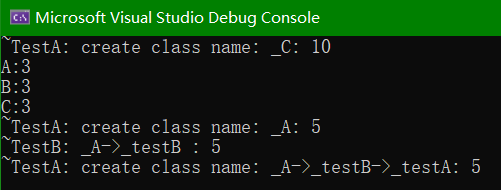各位路过的大神,要看懂我这篇文章,需要看一下我的第一章笔记:
https://blog.csdn.net/acdfg123/article/details/118226287?spm=1001.2014.3001.5502
我这一章是基于前一章的序章,后续的笔记都是由第一章的最基础工程来进行实验
1.创建新类 TestB(直接复制TestA的内容),内容如下:
class TestB
{
public:
TestB(const std::string inName) :_name(inName), _val(-1) {}
TestB(const std::string inName, int inVal) :_name(inName), _val(inVal) {}
~TestB()
{
std::cout << "~TestB: " << _name << " : " << _val << std::endl;
}
private:
std::string _name;
int _val;
};2. 修改 TestA 的内容,修改后如下
class TestA
{
public:
TestA(const std::string inName)
:_name(inName),
_val(-1),
_testB(new TestB(inName + "->_testB",_val))
{
}
TestA(const std::string inName,int inVal)
:_name(inName),
_val(inVal),
_testB(new TestB(inName + "->_testB", _val))
{}
~TestA()
{
std::cout<<"~TestA: create class name: " <<_name<< ": " <<_val << std::endl;
}
private:
std::string _name;
int _val;
CSharedPtr<TestB> _testB;
};其它代码保持不变,运行输出结果如下:

由结果看出:在 _C 被销毁后,其里面的智能指针变量 _testB 其后才被销毁,_A也是如此
由此得出销毁顺序:类 —>类里的智能指针变量
3.再次修改TestB代码,在TestB中添加一个智能指针变量,并修改构造,修改结果如下
TestB.h 文件
#pragma once
#include <iostream>
#include <cstring>
#include "Shared.h"
class TestA;
class TestB
{
public:
TestB(const std::string inName);
TestB(const std::string inName, int inVal);
~TestB()
{
std::cout << "~TestB: " << _name << " : " << _val << std::endl;
}
private:
std::string _name;
int _val;
CSharedPtr<class TestA> _testA;
};TestB.cpp文件
#include "TestB.h"
#include "TestA.h"
TestB::TestB(const std::string inName)
:_name(inName), _val(-1), _testA(new TestA(inName + "->_testA", _val,false))
{}
TestB::TestB(const std::string inName, int inVal)
: _name(inName), _val(inVal), _testA(new TestA(inName + "->_testA", _val,false))
{}
同样的TestA的 构造函数实现,全部移到 cpp 里。但是为了避免循环构造,导致崩溃,在TestA里新增了一个构造函数 TestA(const std::string inName,int inVal,bool bCreateTestB = false);后面创建TestA都使用该函数
.h文件修改后的
#pragma once
#include <iostream>
#include <cstring>
#include "Shared.h"
class TestB;
class TestA
{
public:
TestA(const std::string inName);
TestA(const std::string inName,int inVal);
TestA(const std::string inName,int inVal,bool bCreateTestB = false);
~TestA();
private:
std::string _name;
int _val;
CSharedPtr<TestB> _testB;
};cpp文件修改后如下:
#include "TestA.h"
#include "TestB.h"
TestA::TestA(const std::string inName)
:_name(inName),
_val(-1),
_testB(nullptr)
{}
TestA::TestA(const std::string inName, int inVal)
:_name(inName),
_val(inVal),
_testB(nullptr)
{}
TestA::TestA(const std::string inName, int inVal, bool bCreateTestB /*= false*/)
: _name(inName),
_val(inVal),
_testB(bCreateTestB? new TestB(inName + "->_testB", _val) : nullptr)
{}main函数也做出如下修改
#include "Shared.h"
#include "TestA.h"
#include <iostream>
int main()
{
{
CSharedPtr<TestA> _A(new TestA("_A",5,true));
CSharedPtr<TestA> _B(_A);
CSharedPtr<TestA> _C(new TestA("_C",10,false));
_C=_B;
std::cout << "A:"<< _A.GetCount() << std::endl;
std::cout << "B:"<< _B.GetCount() << std::endl;
std::cout << "C:"<< _C.GetCount() << std::endl;
}
return 0;
}然后运行结果

结果可以看出类的销毁顺序为:类 —>类里的智能指针变量类1—>类1里的智能指针变量类2
从代码实验结果来看,智能指针的销毁顺序是一个
类 —>类里的智能指针变量类1—>类1里的智能指针变量类2—>类2里的智能指针变量类3—>......
这样的一个过程,它会从最开始的那个类,一直向里面的智能指针变量,逐级进行删除销毁